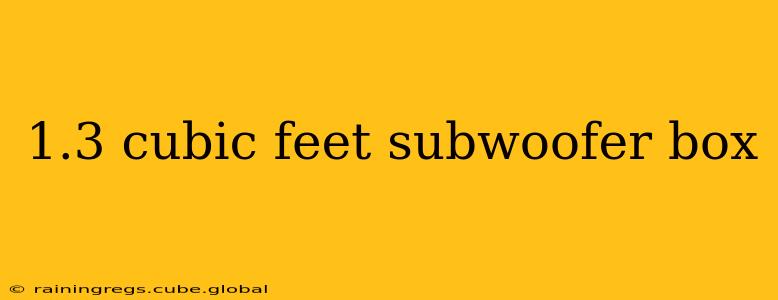Building or buying a subwoofer box is a crucial step in achieving high-quality, impactful bass in your audio system. A 1.3 cubic feet subwoofer box is a popular size, suitable for a range of subwoofers, but choosing the right one requires careful consideration. This guide will explore the key factors involved in selecting and building a 1.3 cubic foot subwoofer enclosure.
What Size Subwoofer Fits in a 1.3 Cubic Foot Box?
This is a frequently asked question. The answer isn't a simple one-size-fits-all. A 1.3 cubic foot box is suitable for various subwoofer sizes, but the ideal fit depends heavily on the subwoofer's specifications. The manufacturer's recommendations are paramount. Always check the subwoofer's specifications for the recommended enclosure size and type (sealed, ported, etc.). Ignoring these recommendations can lead to poor performance and even damage to the subwoofer. Look for the recommended box size in cubic feet directly on the subwoofer's documentation or the manufacturer's website. Some subwoofers might perform optimally in a slightly smaller or larger enclosure, but staying within the recommended range is crucial.
What Type of Box is Best for a 1.3 Cubic Foot Subwoofer?
There are several enclosure types to choose from: sealed, ported, and bandpass. Each affects the subwoofer's performance differently.
-
Sealed enclosures: These are simple to build and offer a tighter, more accurate bass response, but generally have lower output compared to ported enclosures of the same size. A 1.3 cubic foot sealed enclosure is a good choice for applications where accuracy and controlled bass are prioritized over sheer volume.
-
Ported enclosures: These utilize a port (tube) to enhance the bass output and extend the low-frequency response. However, designing a ported enclosure requires more precise calculations to determine the correct port dimensions and tuning frequency. A poorly designed ported enclosure can result in a muddy or boomy sound. A 1.3 cubic foot ported enclosure can offer significant output gains but demands careful design.
-
Bandpass enclosures: These are more complex and typically less common for home audio setups. They offer very high output but often at the expense of a less linear frequency response.
How Do I Build a 1.3 Cubic Foot Subwoofer Box?
Building your own subwoofer box offers cost savings and the ability to customize the design. However, it requires careful planning and execution.
-
Design: Use specialized subwoofer box design software (many free options are available online) or consult online resources to create plans for your enclosure, ensuring the internal volume is precisely 1.3 cubic feet. Account for the internal bracing and the displacement of the subwoofer itself.
-
Materials: Use MDF (medium-density fiberboard) for its strength and rigidity. Other materials are possible, but MDF is the industry standard.
-
Construction: Precise cuts and accurate assembly are essential. Use wood glue and screws to ensure a strong and airtight seal.
-
Finishing: After assembling, ensure the box is airtight. Apply damping material (like polyfill) inside the box to reduce internal resonance and improve sound quality. Finish the exterior to match your aesthetic preferences.
Can I Use a 1.3 Cubic Foot Box for Any Subwoofer?
No. As mentioned earlier, the subwoofer's specifications determine the appropriate enclosure size and type. Using a 1.3 cubic foot box with a subwoofer that requires a different volume or enclosure type will likely result in suboptimal performance, including reduced output, distortion, or even damage to the subwoofer. Always consult the subwoofer's manual for the recommended enclosure specifications.
What are the Advantages of a 1.3 Cubic Foot Subwoofer Box?
A 1.3 cubic foot subwoofer box offers a good balance between size, portability, and performance for many subwoofers. It's compact enough for many applications but still offers sufficient volume for decent bass output, especially when paired with appropriately sized subwoofers and carefully designed enclosures.
Conclusion
Choosing and building a 1.3 cubic foot subwoofer box requires careful consideration of the subwoofer's specifications, the desired enclosure type, and the construction process. Prioritizing accuracy in design and construction will result in a significantly better listening experience. Always consult the subwoofer manufacturer's recommendations before undertaking any subwoofer enclosure project.
